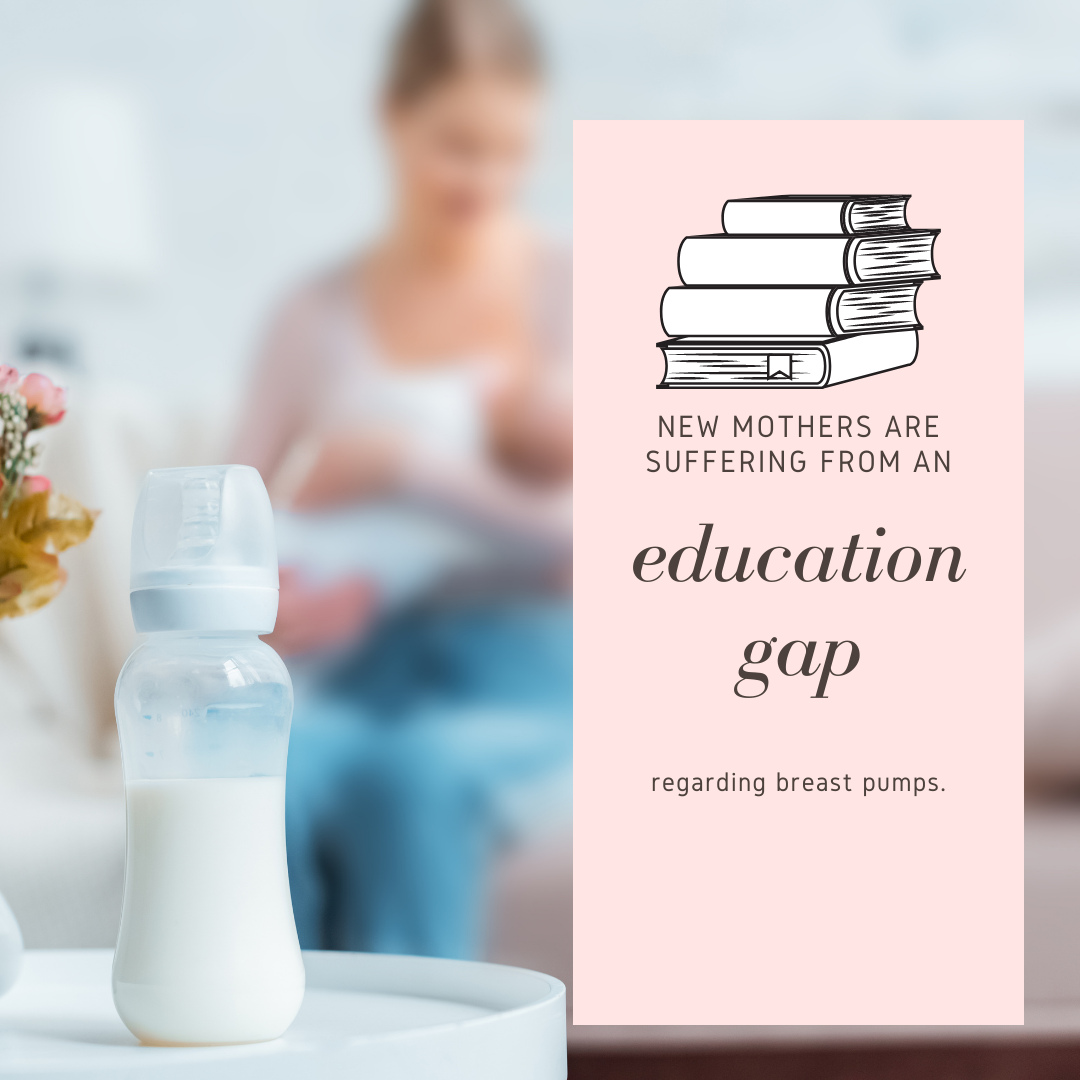New Mothers Are Suffering from an Education Gap Regarding Breast Pumps
Mommy Care Team
Board Certification Programs for Lactation Professionals is Painfully Lacking Necessary Information on Breast Pumps and Their Usage

Since the invention of the breast pump in the mid nineteenth century, an entire economy has evolved around lactation and infant nutrition. Orwell H. Needham was first to receive a breast pump patent in 1854. That means breast pumps have existed for over 167 years!
If we’ve found this technology useful or necessary for so long, then why is there such limited training for lactation professionals? New mothers are suffering from this education gap and not receiving the instruction, advice, and support that could save the breastfeeding journeys of so many.
The Evolution of Studies on Breast Pumps and How They Are Closing the Education Gap for Mothers

In this post, we’re going to look into the evolution of information relating to breast pumps and delve into what has been gleaned by their use over the course of these 167 years. As you will see in the following examples, we are only now starting to see more clinical research into pumping and the various uses of breast pumps, etc.
In 2010, a randomized trial comparing hand expression and breast pumps found that mothers who hand expressed were more likely to be breastfeeding at two months. It confirmed that hand expression and pumping work, but where possible hand expression should be recommended.
In 2014, the study Positive and Negative Experiences of Breast Pumping During the First 6 Months, offers only one out of six experiences as positive. It suggests that shortly after a mother begins pumping, a clinician should evaluate her experience so that pumping does not become a barrier to successfully breastfeeding the baby.
The outcome of a 2015 study on mother’s intentions on pumping determined that lactation support was needed to reduce new mother’s concerns about having insufficient milk supply right after delivering their baby. It went on to suggest that clinicians should be aware of how early mothers intend to use their pumps to avoid using them in an injurious way. A more positive outcome to the study would be that professionals should be trained on how to use the pumps in order to educate mothers so that they can successfully and safely express milk for their babies.
In 2016, Methods of Milk Expression for Lactating Women was published in an attempt to study the effectiveness and safety of various expression methods and their effect on breast milk.
Fast Forward to 2017, articles started to focus more on the reasons women pump, like this one. The study focuses on the perceptions of mothers regarding pumping which is interesting and sheds light on the reasons more mothers are choosing to pump.
While studies are moving in the right direction, they are not directly impacting moms. Lastly, none of them provide lactating parents with concrete or actionable advice. There is no information on how to size yourself for your pump. There is no indication of how often, how long, or when to pump. There is no information on how much output a mother should expect or a typical range in what is considered normal output. Over suppliers are left to wonder whether they should express the extra, or if it will worsen their situation.
Lactation Professional Training Programs and the Education Gap

Let me be explicit here: We are not criticizing IBCLCs and CLCs. We love these professionals. Instead, we are recognizing that these professionals are left with their hands tied behind their backs when it comes to pumping moms. They’re not given the tools in their training programs to be able to confidently lead a mother through her pumping journey unless she has actually gone through it herself and figured it out.
We’ve spoken to women who have gone through these training programs and they have attested that in the grand total of over 200 pages of textbook training materials, only about four pages are dedicated to expression. Two of those are related to hand expression, and two are related to pumping. It’s no wonder that misinformation or a lack of information exists.
If the people who are supposed to have the higher levels of education are left with a gap, most certainly the parents in the trenches are left to navigate this same gap on their own. Parents must go to a number of different resources including breast pump websites and manuals, educational blogs and community groups from others who have pumped before them.
Thank goodness for the women like Amanda Glenn of Exclusive Pumping.com, Sandy Green of Empowered Pumping, and Instagram accounts like @pumpmommapump, who share information based on their experience, and the experiences of other women, so that we can add up our own data and make better informed decisions.
Breastfeeding Is Not for Every Body but with Pumping, It Can Be.

Our cushions were inspired by a woman who had been there, who had searched in vain for information that could help save her breastfeeding journey from the prohibitive pain of hard plastic flanges.
Physical Anatomy
Our bodies are all different. So why do we assume that all breast and nipple tissue are the same? Some mothers have flat nipples which don’t give our babies a great chance of latching. Some have inverted nipples. Instead of teaching us how to properly express milk, some of these poor moms are encouraged to “correct” their nipples which can be extremely painful. And others still have elastic nipples which come with their own unique set of challenges.
Others still are survivors of trauma and as a result are not comfortable with breastfeeding. Tongue and lip ties can make breastfeeding difficult for babies and not all parents are ready or willing to have these corrected.
Unforeseen Difficulties
All of these are examples of obvious reasons why breastfeeding can be difficult. There are plenty of families who have far less visible complications and struggle with biological nursing. Breastfeeding is like a complicated dance in which two people must work together. Challenges can arise on either side as we have previously discussed. Beyond those physical challenges though, there is a relationship that must be developed and outside factors may have a drastic impact. Stress and pain while nursing can have a drastic impact and may get so bad that it is impossible for the duo to make it work.
Modern Families
Same sex couples are now able to use surrogacy and adoption to grow their families. Trained lactation staff can help new parents encourage their bodies to lactate in order to feed their babies, but what about those who are not able to, or do not feel comfortable with biological breastfeeding? Breast pumps can be really effective means for these families to give their new babies the best nutrition possible.
Donation
More and more lactating people are choosing to donate breast milk. Parents who are grieving the loss of their child sometimes find that paying forward the gift of their milk helps them heal and celebrate their beautiful baby. Some parents are blessed with an oversupply, which can be painful if not expressed or treated. These parents might also choose to donate their extra supply to milk banks. In both of these cases, breast pumps are really important. Having someone to show you how to use, when to use, how to clean, and care for your pump can make all of the difference.
Pumping and bottle feeding can make providing the nutrition and protection of breast milk feasible for these families.
It all Comes Back to the Lack of Clinical Research and Data

Many of these mothers are instructed to give formula, rather than instructed how to pump. Formula isn’t evil, at least it isn’t now. The mom writing this post has fed her child a supplemental formula because no one told me that I could use a pump to encourage my milk supply to come in. Rather than starve my baby, we continued to breastfeed as we supplemented with formula. But there are ways in which lactating parents can use breast pumps to encourage their milk to come in and to increase their milk supply. This information isn’t always shared because it hasn’t been clinically studied or extensively researched. So while it could make all the difference for a mother who desires to breastfeed her child, the information is potentially withheld because it cannot be backed with concrete data.
So What Is a Mom to Do?
If you’ve made it this far, you likely already know the impact a breast pump can have for a lactating dyad. You might feel helpless or like you don’t have the ability to make a difference, after all most of us are not researchers, lactation professionals, etc. But each of us can make a difference just by discussing breast pumps, sharing information with our friends, and promoting the resources that are available. We can talk to our medical providers and lactation professionals about the lack of information and ask for more research. If enough of us raise our voices to create a discussion around breast pumps and their place in the definition of breastfeeding we can and will be heard. We can close the educational gap for new moms.
